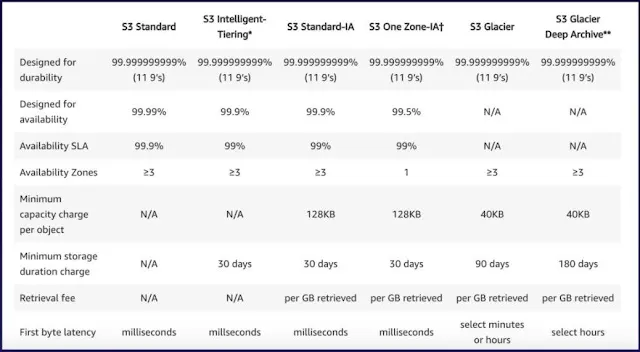S3 stands for 'Simple Storage Services'. It is a storage solution provided by AWS in its cloud system. You can upload/download data to your S3 in AWS.
Below are the properties of Simple Storage Service.
Object Based: S3 is an object based storage
solution, that means what you upload to S3 is treated as a
file. but it is different from EBS which
stands for 'Elastic Block Storage' that means you can not use S3 storage
for creating any virtual machine.
Global Name space: S3 is defined globally that means bucket name must be unique globally e.g https://itguyakay.s3.ap-south-1.amazonaws.com/ but you can create your bucket for any specific
region & also replicate that bucket to another region as a backup.
Data Consistency: Two type of consistency found in S3.
read after write consistent: when you put an new object to your S3 bucket it is always work as read after write consistency means you can might be able to read the data then only after you can write on that.
eventually consistent: when you try to write to an existing object it is always work as eventual consistency that means you might read an old or new object but you will never get an error on that object.
Static Web Hosting : You can Host a static page using S3 which does not required any server technology.
Object Locking: Prevent from deleting your data.
Features In AWS S3:
- Tiered storage available
- Life cycle management
- Versioning
- Security using encryption
- Protect data using ACL & Bucket policies
- Access point for your bucket
- backup using replication
- Analytics, to analysis your data for automatic move to specific class
- Inventory
- MFA delete
Storage Classed In S3:
- S3 -Standard:
- S3-Standard IA
- S3-One zone IA
- S3-Intellegent Tier
- S3-Reduce redundancy
- S3-Galcier
- S3-Deep Glacier
Key parts of an object in S3:
- key :Name of the object itself is the key.
- Value: Data of an object is called value.
- Version ID: An ID which is allotted when the versioning is enabled.
- Meta Data: Data about an object is called metadata.
- Sub resources : ACL & Torrent
Policies in S3 bucket:
- Bucket Policies
- ACL Policies
Encryption:
- SSL/TLS is used while transition.
- Server side managed by AWS as follows
- S3 Managed Keys SSE-S3
- AWS key Management Service , Managed Keys -SSE-KMS
- Server side encryption with customer provide keys-SSE-C
- Client side encryption
Versioning:
- Store all versions of your object (even you delete the object)
- acts like a backup tool
- Once enabled , You can not disable the versioning (only can suspend)
- Integrated with life cycle rule
- MFA Delete capability
Cross Region Replication:
- Versioning must be enabled on both the source & destination bucket
- Region must be unique
- Deleted objects or individual version will not be replicated.
- Existing files will not be automatically replicated
- Only subsequent objects can be replicated.
S3 acceleration: To boost up uploading speed , AWS CloudFront Edge Network service is used to upload the object to nearest edge location then upload the object to your S3 bucket.
Remember:
- S3 is object base storage service
- File can be upto 5TB
- There is unlimited storage
- Files are stored in buckets
- Name for S3 bucket should be unique globally
- S3 is different storage type from EBS(not for EC2 instances)
- MFA delete option available for accidentals deletion
- you can create up to 100 buckets in each of your AWS accounts. but you can add more buckets up-to 1,000 by submitting a service limit increase.
- Replicate your data from one region to another region for disaster recovery or backup is called Cross Region Replication.
- HTTP200 status code for successful upload file.
Sharing is Caring 😀











0 Comments